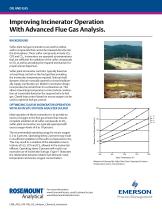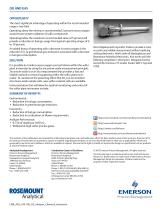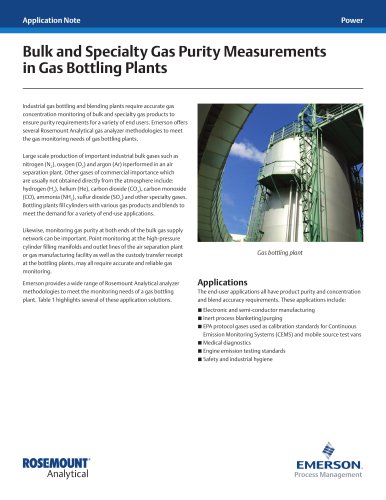
Excertos do catálogo

Improving Incinerator Operation With Advanced Flue Gas Analysis. BACKGROUND Sulfur plant tail gas incinerators are used to oxidize sulfur compounds that cannot be released directly into the atmosphere. These sulfur compounds include H2S, COS and CS2. Incinerators are operated at temperatures that are sufficient for oxidation of the sulfur compounds to SO2 as well as providing the required mechanism for proper plume dispersion. Sulfur plant incinerator control is typically based on a closed loop control on the fuel gas flow providing the incinerator temperature required. Natural draft dampers that are manually opened or closed traditionally supply combustion air. Modern incinerator design incorporates forced draft air for combustion air. This allows closed loop temperature control where combustion air is provided based on the required ratio to fuel gas. Closed loop control based on excess oxygen can be used to optimize fuel gas control. OPTIMIZING SULFUR INCINERATOR OPERATION WITH AN IN SITU OXYGEN ANALYZER SULFUR The recommended operating range for excess oxygen is 2 to 5 percent. Operating below 2 percent may result in insufficient oxidation of the sulfur compounds to SO2. This may result in a violation of the allowable concentrations of H2S, COS and CS2 allowed in the incinerator effluent. Operating above 5 percent will result in an excessive use of incinerator fuel gas. Figure 1 illustrates the relationship between relative fuel demand, stack temperature and excess oxygen concentration. • Relative Fuel Demand (Percent) Ideal operation of these incinerators is to provide an excess of oxygen in the flue gas stream that ensures complete oxidation of all sulfur compounds to SO2. Sulfur plant incinerators are typically operated with excess oxygen levels of 6 to 10 percent. Relative Fuel Demand for Sulfur Plant Stack Operated at Various Temperatures and O2 Concentrations For more information www.EmersonProcess.com/CustomerSuccess www.RosemountAnalytical.com
Abrir o catálogo na página 1
OIL AND GAS OPPORTUNITY The most significant advantage of operating within the recommended range is two-fold: Operating above the minimum recommended 2 percent excess oxygen would ensure proper oxidation of sulfur compounds. Operating below the maximum recommended value of 5 percent will provide a reduction in fuel gas usage from typical operating ranges of 6 to 10 percent. An added bonus of operating with a decrease in excess oxygen is the reduction CO2 (a greenhouse gas) emissions associated with a decrease in fuel gas consumption. SOLUTION It is possible to monitor excess oxygen...
Abrir o catálogo na página 2Todos os catálogos e folhetos técnicos Emerson Automation Solutions - ROSEMOUNT
-
VPS 53 Vapor Pressure Sensor
2 Páginas
-
ROSEMOUNT 3051 PRESSURE PRODUCTS
2 Páginas
-
EasyHeat™ XD Cable Kits
2 Páginas
-
FRL Accessories
14 Páginas
-
TankRadar Pro
32 Páginas
-
Rosemount™ 2140 Level Detector
22 Páginas
-
Roxar subsea SenCorr PTPT sensor 10K
2 Páginas
-
Roxar subsea PIG
2 Páginas
-
Roxar subsea SenCorr PTPT sensor 15K
2 Páginas
-
Roxar subsea Sand monitor
2 Páginas
-
Roxar subsea CM10K
2 Páginas
-
Roxar PTPT15K
2 Páginas
-
Rosemount TankRadar OFC
2 Páginas
-
Rosemount™ 2140:SIS Level Detector
22 Páginas
-
Rosemount 5708 Series 3D Solids Scanner
30 Páginas
-
SW-300
4 Páginas
-
DL8000
12 Páginas
-
Rosemount™ 8800D Series Vortex Flowmeter
82 Páginas
-
Rosemount™ 3144P Temperature Transmitter
82 Páginas
-
Rosemount™ 3051 Pressure Transmitter
82 Páginas
-
DeltaV Analyze
8 Páginas
-
Fisher 657 and 667 Diaphragm Actuators
16 Páginas
-
DeltaV SIS with Electronic Marshalling
48 Páginas
-
AMS Machine Works
4 Páginas
-
Emerson Smart Wireless Gateway
4 Páginas
-
DeltaV Executive Portal
7 Páginas
-
Fisher 646 Electro-Pneumatic Transducer
20 Páginas
-
1500XA Gas Chromatograph
8 Páginas
-
Rosemount 3051S Series of Instrumentation
162 Páginas
-
Rosemount 975UR
4 Páginas
-
Rosemount 975HR
4 Páginas
-
Rosemount 975UF
4 Páginas
-
Rosemount 975MR
4 Páginas
-
CT5400 Process Gas Analyzer
4 Páginas
-
CT5200 Industrial Gas Analyzer
4 Páginas
-
CT2211 Leak Detection System
4 Páginas
-
OPM 4001 Opacity/Dust Density Monitor
12 Páginas
-
6888 In Situ Flue Gas Oxygen Transmitter
16 Páginas
-
Combustion Analysis Solutions
6 Páginas
-
X-STREAM X2GK - Compact Gas Analyzer
8 Páginas
-
Process Gas Analysis Solutions
8 Páginas
-
On-line Gas Analysis in Urea Plants
2 Páginas
-
Lye Peeling of Fruits and Vegetables
2 Páginas
-
Leak Detection Using Conductivity
3 Páginas
-
Improve Copper Yield in Flotation
2 Páginas
-
Desalination of Seawater
2 Páginas
-
Conductivity Measurements in Brewing
2 Páginas
-
Chemical Concentration Control
2 Páginas
-
700XA Process Gas Chromatograph
12 Páginas
-
Fixed Gas Detector Calibration Kits
2 Páginas
-
MT Ultrasonic Portable Mapping Tool
2 Páginas
-
Incus Ultrasonic Gas Leak Detector
6 Páginas
-
01-TT Ultrasonic Portable Test Tool
2 Páginas
-
SafeGuard Alarm Controller
2 Páginas
-
Safety Monitoring
6 Páginas
-
Advanced Power Analytical Solutions
8 Páginas
-
AMS Suite
16 Páginas
-
Drinking Water Sht 2V2
2 Páginas
-
Liquid Analysis for Metal Extraction
12 Páginas
-
Line Card
2 Páginas
-
Installation & Calibration Equipment
48 Páginas
-
Drinking Water Industry
16 Páginas
-
SafeGuard 16 Channel Controller
2 Páginas
-
Explosion Proof Motion Detector
2 Páginas
-
Explosion Proof Video Camera
2 Páginas
-
Phoenix Triple IR Flame Detector
4 Páginas
-
Net Safety UV/IR Flame Detector
4 Páginas
-
Net Safety UV Flame Detector
4 Páginas
-
Millennium II BASIC Gas Detector
4 Páginas
-
Millennium Toxic Gas Detector
2 Páginas
Catálogos arquivados
-
UV/IRS Flame Detector
4 Páginas
-
UVS Flame Detector
4 Páginas
-
UV/IRS-H2 and UVS-H2 Flame Detectors
6 Páginas























































































































































